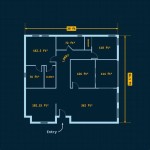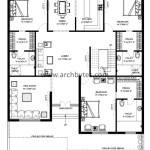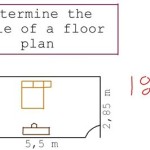How Do I Get A Floor Plan Of My Property?
Obtaining a floor plan of a property is a crucial step in various situations, ranging from home improvement projects to legal documentation. A floor plan serves as a visual representation of a building's layout, accurately depicting the dimensions, walls, doors, windows, and other structural features. This detailed diagram provides a clear understanding of the spatial organization of a property, essential for planning renovations, interior design, real estate transactions, and emergency preparedness. Several methods exist for acquiring a floor plan, each offering varying levels of detail and accuracy. The optimal approach depends on the specific needs and available resources of the individual or entity seeking the floor plan.
Accessing a floor plan can significantly streamline various processes. For homeowners contemplating remodeling, a floor plan allows for accurate measurement of spaces, enabling precise material estimations and facilitating the visualization of potential design changes. Architects and contractors rely on floor plans to develop detailed construction documents and execute projects according to the intended specifications. Real estate professionals utilize floor plans to market properties effectively, providing potential buyers with a comprehensive overview of the layout and dimensions. Furthermore, in the event of an emergency, floor plans can assist first responders by offering critical information about the building's structure and layout, enabling them to navigate the space more efficiently and effectively.
Review Existing Documents
The initial step in obtaining a floor plan involves exploring readily available resources. Often, floor plans are included within the documentation associated with the property. This documentation may consist of architectural drawings, building permits, or homeowner's association (HOA) records. Architectural drawings, typically created during the initial construction or any subsequent renovations, provide the most detailed and accurate representation of the property's layout. Building permits, required for various construction projects, often include floor plans to ensure compliance with building codes and regulations. HOA records, particularly for condominiums or planned communities, may contain floor plans for individual units or the entire complex. Contacting the local building department or HOA can prove fruitful in locating relevant documents that contain existing floor plans.
When examining these documents, pay close attention to the scale and dimensions indicated on the plan. The scale determines the relationship between the drawing and the actual size of the property. A common scale is 1/4 inch equals 1 foot (1/4" = 1'). Understanding the scale is essential for accurately interpreting the dimensions and calculating areas within the plan. Also, verify the date of the floor plan to ensure it reflects the current configuration of the property. Renovations or additions completed after the date of the plan may render it inaccurate. If the documents are digital, check for version control information to ensure you possess the most up-to-date version.
Furthermore, consider the purpose for which the original floor plan was created. A floor plan intended for construction purposes will typically include significantly more detail than a floor plan designed for marketing purposes. Construction documents will often delineate structural elements such as load-bearing walls, plumbing lines, and electrical wiring, while marketing floor plans may focus primarily on the overall layout and room dimensions. Understanding the intended use of the original floor plan can help you assess its suitability for your specific needs.
Hire a Professional Surveyor or Architect
If existing documents are unavailable or inaccurate, engaging a professional surveyor or architect constitutes a reliable method for obtaining a precise floor plan. These professionals possess the expertise and equipment necessary to accurately measure the property and create a detailed drawing reflecting its current layout. A surveyor typically focuses on establishing property boundaries and topographic features, while an architect specializes in the design and construction of buildings. Both professionals can create floor plans, but an architect may offer more comprehensive design services if renovations or alterations are planned.
The process typically begins with a site visit, during which the surveyor or architect will meticulously measure the interior and exterior dimensions of the property. They will utilize tools such as laser measuring devices and tape measures to ensure accuracy. The professional will also document the location of walls, doors, windows, staircases, and other fixed features. In addition, they may note the placement of plumbing fixtures, electrical outlets, and other utilities. This comprehensive data collection forms the basis for the creation of the floor plan.
Upon completion of the measurements, the surveyor or architect will draft the floor plan using computer-aided design (CAD) software or other specialized drafting tools. The resulting plan will accurately represent the property's layout, including dimensions, wall thicknesses, and the location of all significant features. The floor plan can be provided in various formats, such as PDF, DWG (AutoCAD drawing), or other digital file types. The cost of hiring a professional depends on the size and complexity of the property, as well as the level of detail required in the floor plan. Obtaining quotes from multiple professionals is recommended to ensure a competitive price.
Create Your Own Floor Plan
For those seeking a cost-effective alternative to hiring a professional, creating a floor plan independently is feasible. This approach requires careful measurement, attention to detail, and the use of available tools and resources. While the accuracy of a self-generated floor plan may not match that of a professionally created one, it can still provide a useful representation of the property's layout for various purposes, such as planning furniture arrangements or visualizing minor renovations.
The first step involves meticulously measuring each room and hallway in the property. Use a measuring tape to determine the length and width of each space, as well as the dimensions of doorways, windows, and other fixed features. Record these measurements accurately and consistently. It is helpful to create a rough sketch of the property's layout before beginning the measurements, as this will provide a framework for organizing the data. Ensure that all measurements are taken in the same units (e.g., feet or meters) to avoid errors. Pay close attention to the orientation of the rooms and hallways, and note any angles or irregular shapes.
Once the measurements are complete, transfer the data to a drawing tool or software program. Several free or low-cost floor plan creation tools are available online. These tools typically provide a user-friendly interface and allow users to draw walls, insert doors and windows, and add dimensions. Alternatively, a traditional approach involves using graph paper and a ruler to create a scaled drawing of the property's layout. Regardless of the method chosen, ensure that the drawing accurately reflects the measurements and relationships between the different spaces. It is also important to label each room and include relevant details, such as the location of plumbing fixtures and electrical outlets.
Furthermore, smartphone apps and online tools are available that assist in creating floor plans. Some apps utilize augmented reality (AR) technology to measure spaces and generate floor plans automatically. Although these methods can be less accurate than professional surveying, they offer a quick and relatively simple way to obtain a basic floor plan. The accuracy of these tools depends on factors such as the quality of the device's camera and the lighting conditions in the room. It is crucial to verify the measurements obtained through these methods with a measuring tape to ensure a reasonable level of accuracy.
Regardless of the method used, it is advisable to create multiple versions of the floor plan, each focusing on different aspects of the property. For example, one floor plan might depict the structural layout, while another might illustrate the placement of furniture and appliances. This approach allows for a more comprehensive understanding of the property's spatial organization and facilitates various planning activities.
In conclusion, obtaining a floor plan of a property can be accomplished through several avenues, each with its own advantages and limitations. Examining existing documents, engaging a professional surveyor or architect, and creating a floor plan independently offer distinct approaches to acquiring this valuable information. The optimal method depends on the specific requirements, budget, and expertise of the individual or entity seeking the floor plan.

How Do I Get A Floor Plan For My Property

House Plans How To Design Your Home Plan

9 Ways To Find Floor Plans Of An Existing House Blueprints Archid

House Plans How To Design Your Home Plan

House Plans How To Design Your Home Plan

Site Plans What They Are And How To Create One

Site Plans What They Are And How To Create One

Where You Can Buy House Plans Live Home 3d

How To Find Building Plans For My House Architecture Design Plan

House Plans How To Design Your Home Plan
Related Posts








